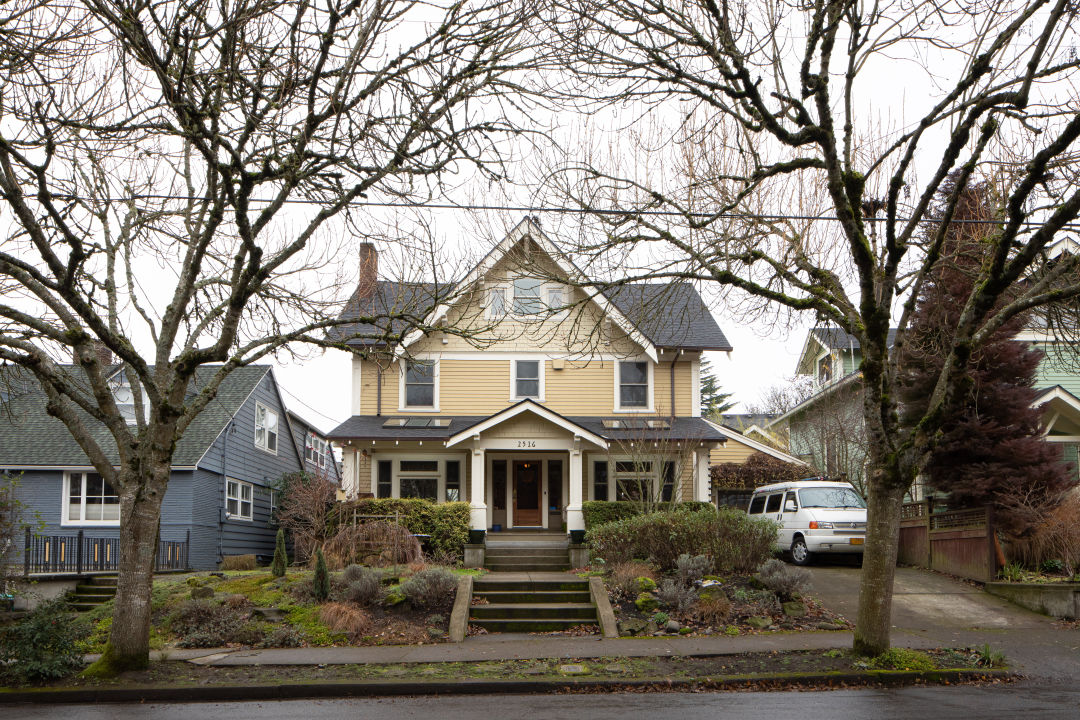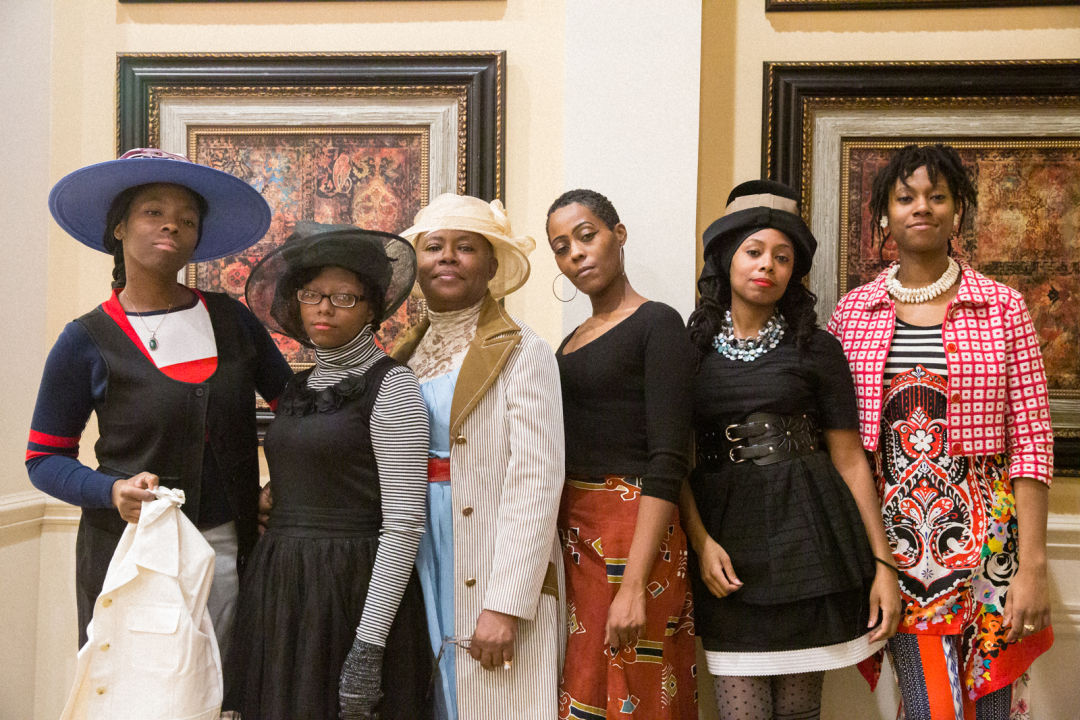Reclaiming Beatrice Morrow Cannady’s Home and Legacy

Pioneering journalist and civil rights activist Beatrice Morrow Cannady once lived in this Northeast Portland home. Now a family of Black female artists wants to purchase it and carry on her legacy.
Image: Intisar Abioto
A million-dollar Craftsman home in Portland’s Grant Park neighborhood went up for sale in early September. But there’s more to its story than its craftsman-style gabled roofs and stained-glass windows.
Nearly a century ago, the home belonged to Beatrice Morrow Cannady, a civil rights activist and editor of The Advocate, a historic Black newspaper in Oregon.
An unnamed party made an offer several days after the house was listed for sale. But photographer Intisar Abioto and her family of women artists––who have lived in Portland for twelve years––have been working to purchase and steward the historic home in recognition of Cannady’s legacy. The Abioto family plan to not only live in the house, but also follow in Cannady’s tradition of using it as a space for art, advocacy, and community.

The Abioto family hopes to someday live in the Cannady home. From left: Kalimah, Medina, Midnite, Ni, Intisar & Yawa Abioto
Image: Intisar Abioto
“Reclaiming this history is important to Oregon and to the future of our identity as people here,” Intisar Abioto says. “We do want this to be a real estate precedent. We don’t want this to be the only one. We want to invite creativity and thoughtfulness and bravery to help make something different here.”
Midnite, Intisar’s mother, says that purchasing the house is a move to address how the real estate industry has long denied Black homeownership. In Portland and the state of Oregon, this has been done through various discriminatory practices, including exclusion laws, redlining, eminent domain, and the ongoing gentrification of historically Black neighborhoods.
“[Cannady’s home] may be a little diamond over in the corner,” Midnite says, “but it shines brightly and it guides others on a path toward restoration.”
We spoke with Intisar and a few of her family members about their effort to purchase the historic home.
Portland Monthly: What is your family’s connection to the home and preserving a place of Black history in Portland?
Intisar Abioto: I first heard about Beatrice Morrow Cannady just from living here in the city and getting to know about it. Hearing about her as a young, Black woman doing what she was doing in her time is very inspirational.
Maybe two years ago, the Architectural Heritage Center/Bosco-Milligan Foundation reached out to me. They asked me to make some photographs of African American historic properties. One of the sites was her house. I was outside making photos of it, and one of the owners invited me inside and showed me some documents about her from the Oregon Historical Society and old paper clippings. So, that kind of sets the stage. And then, about a month ago, I saw an article about her house being for sale.
Kalimah Abioto: I learned about Beatrice Morrow Cannady through my sister [Intisar]. I had not heard of her before, but I had always seen the mural on the side of this building as you go over the St. John’s Bridge. I was really inspired by her story and her legacy, and how that can inform what we do today.
Midnite Abioto: The history of our presence in this state and this city is often not talked about. So, finding out about the home is an exciting proposition really because of the exclusionary laws that came about in this state. Whenever we can find out and uncover our history, it is amazing.
Portland Monthly: What are your plans for the home?
Intisar: As Black women advocates and artists, we stand in her legacy, and we are well-equipped to engage that history and activate it in the public sphere. People of her same providence are working here today. And what she was experiencing in Portland and in Oregon has its forms today. We have the housing crisis. We continue to have intergenerational displacement. So, this is to reclaim her home and Black history and community. We want to set a precedent.
We’ve learned so much about her. I’ve been spending time in The Oregonian archives and The Advocate archives, and just learning about everything she did and the people who stayed at her house. W.E.B Du Bois stayed there. Paul Robeson visited there. She had these interracial tea [parties].
It's a property of historic significance. And there's all these thoughts about preservation, but for us, in the midst of the housing crisis that Black people have had to endure, we need it to become what Black homes do, which are places of gathering, of intimacy, of truth. It’s got to be a place where we have privacy and sanctum just as [Cannady] did. But it will also be for Black artists and advocates.
Midnite Abioto: The purpose behind getting the home is to not only restore history, but also to highlight what is happening in present day. What Black people are doing in Oregon. And we're doing some amazing things that need to be on the radar, not only in Oregon, but nationally.
It is a house, so we do plan to live there. And we do plan to invoke the ideas and theology that come from the work of Cannady.
Portland Monthly: What has the effort to secure the home been like so far?
Intisar Abioto: After I saw the article, I contacted the owners and they wrote back and said that they had just accepted an offer but they were open to us submitting a backup offer. The house is $1.15 million. So, we just started to fundraise with community members to be put in an offer. Somebody in the community wanted to put in an offer on the house on behalf of what we're hoping to do. So, there's a backup offer on the house. It would allow us to be able to both purchase and secure the house. But we still need support from the community.
Reclaiming this house has inspired me to remember that it’s up to us if we want to change something. To put the power back into ourselves and our communities. [The house] is like a guiding light. We are the force for change––for possibility. History can often sound dusty, but history is fantastical. I’m very much interested in the fantastical aspect of bringing our gifts to a place inspired by a young Black woman. That’s magic. And we ask for people’s belief in the possible.
We're looking for donors who have the capacity to contribute to make this a reality. We're looking for [letters of] support and voices. We need more people to be interested in who she was and what her life and efforts offer us.
Additional information about their fundraising effort can be found at www.reclaimingbeatrice.org




